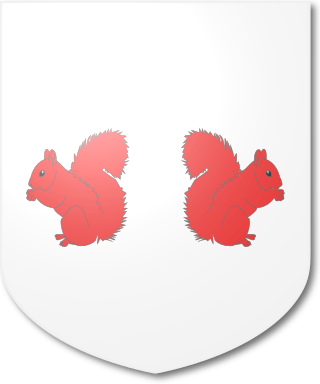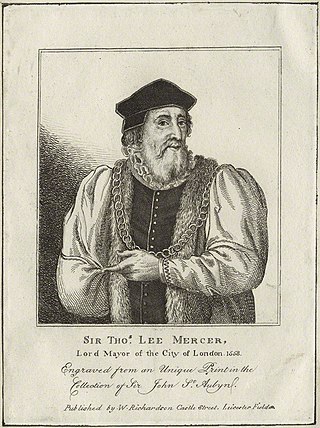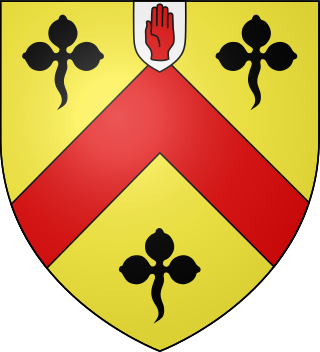Related Research Articles
Sir Isaac Astley, 1st Baronet was an English baronet.
Sir John Barker, 4th Baronet was an English baronet and Tory politician.
Sir Robert Clarke, 2nd Baronet was a British politician who sat in the House of Commons from 1717 to 1722.

The Samwell Baronetcy, of Upton in the County of Northampton, was a title in the Baronetage of England. It was created on 22 December 1675 Thomas Samwell, later Member of Parliament for Northamptonshire and Northampton. He was the great-grandson of Sir William Samwell, Auditor of the Exchequer to Queen Elizabeth I of England. The second Baronet sat as Member of Parliament for Coventry. On the death of the fourth Baronet in 1789, the title became extinct.
Sir Thomas Samwell, 2nd Baronet Samwell, was a British politician who sat in the House of Commons from 1715 to 1722.
Sir Henry Bellingham, 1st Baronet was an English lawyer and politician who sat in the House of Commons from 1625 to 1626. He supported the Royalist cause in the English Civil War.
Sir James Bellingham, 2nd Baronet was an English politician, lawyer and baronet.
Sir William Villiers, 3rd Baronet was an English politician from the Villiers family.
Sir Riggs Falkiner, 1st Baronet was an Irish baronet and politician.
Sir Francis Blundell, 3rd Baronet was an Irish baronet and politician.

Sir Thomas Leigh was an English merchant and Lord Mayor of London in 1558-59. He served as a City Alderman from 1552 until 1571.
Sir Henry Cairnes, 2nd Baronet was an Irish politician, a banker and merchant in London and a baronet in the Baronetage of Great Britain.
The Ingoldsby Baronetcy, of Lethenborough in the County of Buckingham, was a title in the Baronetage of England. It was created on 30 August 1661 for Henry Ingoldsby. The title became extinct on the death of the third Baronet in 1726.

The Warre Baronetcy, of Hestercombe in the County of Somerset, was a title in the Baronetage of England. It was created on 2 June 1673 for Francis Warre, subsequently Member of Parliament for Bridgwater and Taunton. He was the only son of Sir John Warre, of Hestercombe House, Taunton, Somerset, a Knight of the Shire for Somerset. Sir Francis had no surviving male issue and the title became extinct on his death in 1718. His daughter and heiress, Margaret, married John Bampfylde. Their son, Coplestone Warre Bampfylde, succeeded to the family estates.;

The Diggs Baronetcy, of Chilham Castle in the County of Kent, was a title in the Baronetage of England. It was created on 6 March 1665 for Maurice Diggs. He was the grandson of Sir Dudley Digges, Master of the Rolls from 1636 to 1639, and the great-grandson of Sir Thomas Digges, the astronomer and mathematician. The title became extinct on Diggs's death in 1666.
Sir Edward Ward, 1st Baronet of Bixley was twice Sheriff of Norfolk in 1655–56 and 1656–57.
Sir John Thornycroft, 1st Baronet was an English Barrister-at-Law.

Sir Christopher Conyers, 2nd Baronet (1621–1693), was one of the Conyers baronets and Lord Lieutenant of Durham. He married, firstly Elizabeth Langhorne and secondly, Julia Lumley, the daughter of Richard Lumley, 1st Viscount Lumley.

Sir Thomas Drury, 1st Baronet FRS of Wickham Hall near Maldon, Essex, and Overstone, Northamptonshire was an English politician who sat in the House of Commons between 1741 and 1747.

The Abdy baronetcy, of Albyns, in the County of Essex, was created in the Baronetage of England on 9 June 1660 for Robert Abdy. It became extinct on the death in 1759 of the 4th baronet.
References
- ↑ Memorial of Samuel Appleton of Ipswich, Massachusetts (1801), p.53.
- ↑ "Apleton, Roger (APLN583R)". A Cambridge Alumni Database. University of Cambridge.
- ↑ John Burke, A Genealogical and Heraldic History of the Extinct and Dormant Baronetcies of England, Ireland and Scotland (Scott, Webster, and Geary, 1841), p.13.
- ↑ J.B. Nichols, The progresses, processions, and magnificent festivities, of King James the First (1828), p.428.
- ↑ John Burke, A Genealogical and Heraldic History of the Extinct and Dormant Baronetcies of England, Ireland and Scotland (Scott, Webster, and Geary, 1841), p.13.